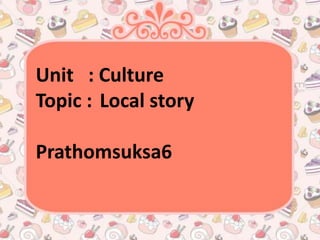
PJ
- 1. Unit : Culture Topic : Local story Prathomsuksa6
- 2. Storytelling in the EFL Speaking Classroom Xu Jianing Suzhou Industrial Park Institute of Vocational Technology (Jiangsu Province, China) Jianing81 {at} yahoo.com.cn
- 3. Introduction As English becomes increasingly important in various fields such as business, finance, industry and education, most Chinese students hope they can speak English fluently. However, from my observations and many EFL teachers' descriptions of their oral English classrooms, a considerable number of students are not responding actively in speaking exercises. How to motivate the students in EFL speaking classrooms has long been our concern. First of all, it is necessary to find out the main factors affecting their participation.
- 4. Warming Up The students listen to some stories downloaded from the Internet and repeat as they listen. This gives them an opportunity to improve their pronunciation, stress and intonation. They are offered three stories each time and required to practice the one they like best. A competition is held every two weeks. When every student has learned to tell three to five stories naturally and expressively, they feel much more confident in telling stories in English than before.
- 5. Activity5 The teacher gives the first sentence to the class and then each student adds one more sentence to make a whole story impromptu. Because there is no preparation and no body has any idea about what the next person will say and where the story is going, there are often lots of fun and surprised in the game. In the process of using stories, the teacher could, in different cases, choose to encourage the students to rewrite the stories, using their own language or ask them to keep the original languages as much as they can. The former way encourages the students to understand the stories and adds their own characteristics to the stories and the latter prompts them to learn to use new words and expression.
- 6. Besides, picture, movies and other materials would also be great help in storytelling. After a few months, the students’ speaking ability can be improved to considerable degree.
- 8. Vocabulary
- 10. delicious (adj.)
- 11. toss (v.)
- 12. Structure
- 13. Past simple The simple past tense is used to talk about actions that happened at a specific time in the past. You state when it happened using a time adverb. Structure: S + V Past (Regular / Irregular)
- 14. For example: There was a couple who lived on the farm. The woman decided to bake a gingerbread cookie in the shape of a man.
- 15. Text
- 17. Activity
- 18. Make up story -You have to add up the storytelling. -Start adding up from the first person until the last person in the class. -After the story has completed, everyone has to write down the whole story by Yourself. -Hand in the paper to the teacher.
